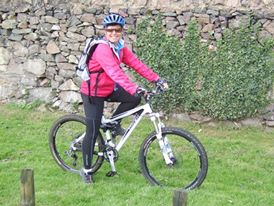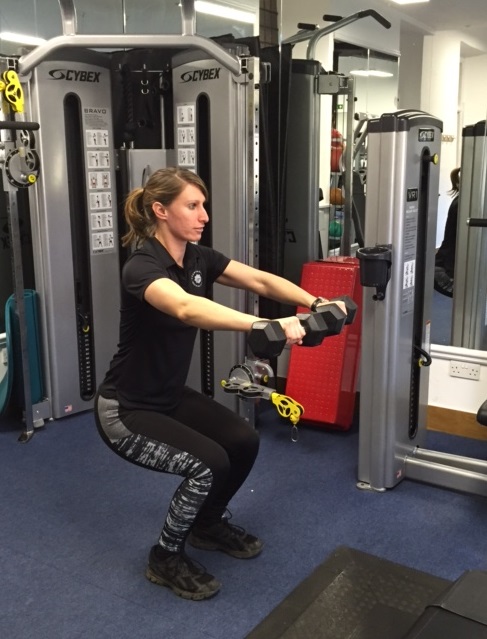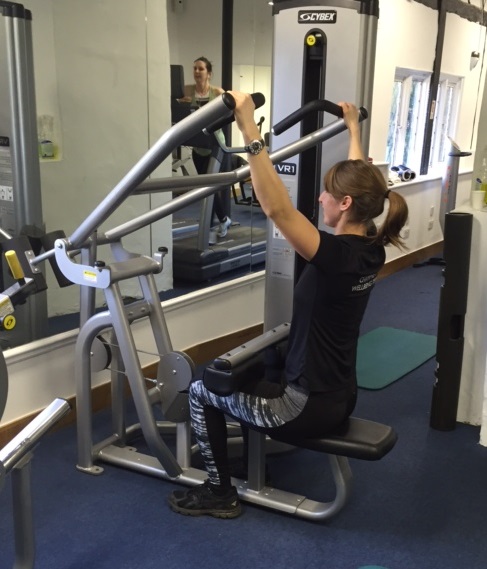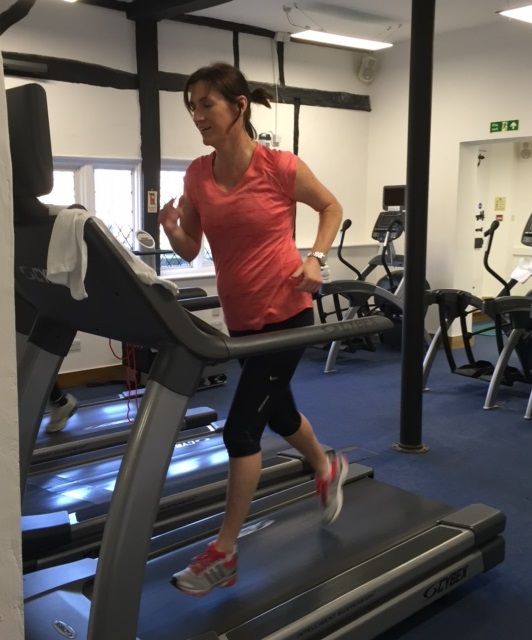Positive Health Online
Your Country

Optimum Exercise and Fitness Regimes to Enhance Weight Loss
listed in exercise and fitness, originally published in issue 229 - April 2016
The old adage of calories in versus calories out although true in principle, has been refined somewhat in recent years. It’s true of course that your energy intake (EI) in relation to how much energy you expend (EE) will influence whether you maintain, gain, or lose weight. However advances in technology have taught us that not all calories are equal, and that not everyone responds in the same way to the same exercise regime. Male and females genetically have a different ratio of muscle (lean body mass - LBM) to fat, and this is a primary differentiator; but there are many additional metabolic variables within each of us that give each of us a unique physiology. In this article we will examine how our bodies burn fat in comparison to other fuel.

The author cycling
Overview of Fuels used for Energy
Under normal circumstances the body uses a combination of 2 fuels for energy:
- Glucose - used by every cell in the body, with the Brain having dominance;
- Fat – used exclusively by muscle cells.
In an altered state such as deliberately fasting or unintentionally having low glucose levels, the body can produce ketones, which like glucose, can be used to fuel the brain. The subject of ketosis - or ketoacidosis, is controversial and for the purposes of this article we will primarily discuss the body’s ‘natural’ state of burning energy i.e. glucose and fat burning, not least because the subject of ketosis is more diet related and can lead to some dis- ease in the body. Glucose and fat both provide energy in the same way that in our homes gas and electricity do, but like gas and electricity they are very different in how they are processed and used, and the amount of heat or energy they can produce.
Glucose is our primary energy source and is obtained through the digestion of carbohydrates into their smallest molecule, i.e. glucose. When we eat foods that are broken down to liberate the glucose very quickly, blood sugar is elevated at a rapid rate. The amount of activity we are undertaking combined with intake will determine blood glucose levels on a moment to moment basis. The energy from glucose is immediately available. In the gas / electric comparison it’s more like electricity than gas, in that if you want instant heat you can turn the electric heater on and heat is immediately produced into the local area.
We are able to store approximately 500 g of glycogen, roughly equivalent to 2,000 calories, in the muscles and as another 100g in the liver as a buffer. When our muscle cells need extra glucose it is available locally so that we don’t have to rely on our circulation to deliver it. Just like turning an electric heater on in one room. It works for that area but does not heat the whole house. As every cell in our body needs glucose, we have to preserve enough circulating blood sugar to maintain normal functions as well as muscle activity, and specifically enough to meet the brains requirement as it operates purely on glucose.
Blood sugar has to be maintained within a fairly narrow range, of approximately 3.5-5.5mmol/l* before meals and less than 8mmol/l, two hours after meals. (*figures from www.diabetes.co.uk) We are all familiar with the term hypoglycaemia, and the effects of low blood sugar as being hungry tired and even irritable, but there are also serious consequences of blood sugar being elevated which include impaired brain function and even suppression of the immune system leading to infection. As with all systems the body is constantly monitoring blood sugar levels and adjusting the amount of fat burnt to preserve glucose or to reduce it. The two factors affecting blood glucose levels are food intake and activity levels.
Fat is stored in the body in fat cells, (adipose tissue). Unlike any other cells in our body fat cells can expand so that they can increase in size to accommodate a higher intake of fat. Unlike glucose there is virtually no limit to the amount of fat a human can store. In addition it is much more energy dense. Glucose has an energy value of 4 calories per gram, whereas fat has a value of 9 calories per gram. On that basis if you want to burn a pound of fat you would need to expend 3,500 calories. This is an oversimplification as the body is constantly making minor adjustment but it does demonstrate the effectiveness of our fat stores in providing us with energy. In our fuel analogy, fat is more like gas. If you want to heat your whole house and you have gas central heating, although it takes a while for the boiler to pump the hot water to every room, once the system is running it can deliver heat throughout the building more effectively and economically than the electric heater in one room.
The main difference between using glucose and fat for energy, is that we can use glucose on its own; cells can simply burn it to generate immediate energy. This type of activity is called anaerobic. The problem is that supplies would run out very quickly if that’s all the energy we had. Fat on the other hand is available in abundance (and over-abundance for many people!) but unlike glucose it cannot be burnt on its own. As mentioned previously the only cells that burn fat are muscle cells, and this occurs within tiny structures inside the cells called mitochondria that work as a furnace; but to create the energy fat must be combined with glucose and oxygen. This is the definition of working aerobically. It literally means - with oxygen. If we could burn fat on its own as we can with glucose, we would be able to go into a gym, do 8 hours on a treadmill, and get off a dress size lighter! But nature has other ideas.
In reality we are all working aerobically even at rest as we need oxygen to survive, but when it comes to aerobic exercise, we need to increase our resting requirements for oxygen by moving our muscles.
Examples of:
|
Aerobic activity |
Anaerobic activity |
|
Brisk walking |
Running |
|
Cycling – moderate pace |
Cycling – fast pace |
|
Swimming – moderate pace Cross trainer – moderate pace low resistance |
Race swimming Cross trainer – increased resistance and or pace |
|
Dancing |
Jumping / fast skipping |
|
Moderate light weight toning exercises |
Weight / higher resistance training |
In reality the threshold between which you are working aerobically or anaerobically is hugely variable. In an unfit individual a brisk walk may be anaerobic as their heart cannot pump the required oxygen around fast enough, whereas for a fit person a brisk walk may be well within aerobic limits.

When it comes to burning fat there are a few key factors. Although I have stated only muscles burn fat, and that when you are working aerobically is the only time you are burning fat, anaerobic exercise is still essential to maximise fat loss. This is because it builds muscle (LBM) which increases your metabolic rate, allowing you to burn more fat. It is estimated that a pound of LBM burns 40 calories per day at rest. That means the more you increase your muscle the more calories you burn. Even at rest. The process of building muscle happens at night when we are in REM sleep and our bodies produce growth hormone, which increase the structure and tone of our muscles. Often people under stress who achieve little REM sleep find it hard to lose weight because they simply cannot build new muscle. This makes relaxation and meditation a surprising yet valuable addition to any weight loss exercise regime.
Imagine 2 cars, one with a 1 litre engine and one with a 2 litre engine, both travelling at 70 miles per hour for 100 miles. Even though the work load is identical, the amount of energy each use would vary, with the larger engine using much more fuel. In simple terms if you include some toning or resistance exercises into your regime, then you are increasing the amount of fat you burn doing everyday tasks like climbing the stairs, vacuuming etc. The amount of LBM we have on our bodies naturally decreases with age, therefore resistance exercise is even more important as we get older. Without it, even if we eat exactly the same as when we were younger, we will get fatter.
Over the years there has been much discussion about which exercise burns the most fat. Typically most experts suggest that activities like cross country skiing where you are using all your large muscle groups together, are the most effective fat burners. That’s not really practical for any city dwellers living in the warmer climates of the western world wanting to lose a few pounds!
Let’s return to the earlier point about combining glucose fat and oxygen, and remembering that we have to sustain adequate blood glucose for brain and other functions; look at how this affects how much fat we do burn when we are active. Imagine you wanted a drink of blackcurrant. You wouldn’t just drink neat blackcurrant, you would dilute it to make the juice go further. If you are getting near the end of the bottle and you cannot get to the shops, you would use less blackcurrant; just enough to give the taste, but increase the ratio of juice to water to make it last longer. This is what your body does when your blood glucose is getting low; it uses more fat to make it last longer. The more fat we are burning the more oxygen we need, so you can only do this when the intensity is low enough for your heart to be able to increase the circulation sufficiently to supply the required oxygen. In this way we adjust the percentage or ratio of glucose to fat being burnt on a moment to moment basis.
However, this can also go the other way, if blood glucose levels are higher, then we burn much less fat as we need to reduce the glucose levels. If glucose levels are too high after a high carb high GI meal, and you are stationary or inactive and therefore burning very little glucose, then extra insulin is released from the pancreas which converts the excess into fat. Once this transmutation has occurred it can’t be reversed. You can turn glucose into fat but not fat into glucose. You have to then burn it as energy.

The ratio or percentage of fat burnt in relation to glucose is therefore dependant on two things, blood glucose levels, and your aerobic capacity. Moderate intensity levels mean that you can provide the required oxygen to enable you to burn fat. If the intensity goes up and you can’t provide oxygen quickly enough, you burn a higher percentage of glucose. For many years personal trainers told clients to actually reduce the intensity to burn more fat to get them into a ‘fat burning zone’. However more recent research has looked not just at the amount of calories burnt during exercise, but at how long after exercise your metabolic rate remains higher. When you stop exercising your metabolic rate can stay elevated for many hours, and this is entirely dependent on how hard you have been working.
The more energy you expend during exercise, even if the ratio of fat / glucose is lower, can result in more fat being burnt.
|
|
Walking |
Running |
|
Distance |
4 miles / 6k |
6 miles / 10k |
|
Speed |
4 mpg / 6 kph |
6 mph / 10kph |
|
Time |
60 minutes |
60 minutes |
|
Total calories expended during exercise |
270 |
680 |
|
% Fat calories |
60% |
40% |
|
Total Fat Calories burnt |
160 |
170 |
In addition to the fact that working harder increases the actual number of fat calories burnt, it also results in your metabolic rate staying elevated for much longer after exercise.

HIITS - High Intensity Training
HIITS is currently the most popular training regime for weight loss. The concept was developed in the 1970s by Arthur Jones who invented the Nautilus range of resistance machines. In simple terms instead of steady state exercise, HIITS is characterized by a burst of high intensity activity for one minute, followed by one-two minutes of recovery. This cycle is repeated up to 10 times depending on fitness levels. In this way the number of minutes required to achieve maximum benefits can be drastically reduced. Because of the nature of working at high intensity, you should get full clearance before embarking on this regime, especially if you are a beginner to exercise. If you have no health contraindications and you take professional advice on how hard to work and for at least the first few sessions do it under supervision, then this may be the most effective form of exercise.
Although you should take medical advice before any form of exercise regime, the benefits of HIITS are not age related and with correct supervision it is appropriate for any age group. In one study[1] participants between the ages of 90-96 all of whom were institutionalised, were put through a HIITS resistance training programme designed specifically to target major muscle groups (as opposed to aerobic fitness). After completion of the programme their walking gate increased by an average of 48%, along with significant gains in LBM.
It has long been suggested that larger abdominal fat stores contribute to cardiovascular risk factors, and research indicates another significant health related benefit of HIITS is that it may be more effective at reducing subcutaneous and abdominal body fat than other types of exercise.[3]
In addition to increased LBM and post exercise calorific expenditure, another benefit of HIITS is that patients with type 2 diabetes show significantly improved blood glucose levels and improved insulin resistance. [2, 3]
References
- JAMA Journal of the American Medical Association. 03440220053029. Retrieved from PubMed. High-Intensity Strength Training in Nonagenarians Effects on Skeletal Muscle Maria A. Fiatarone, MD; Elizabeth C. Marks, MS; Nancy D. Ryan, DT; Carol N. Meredith, PhD; Lewis A. Lipsitz, MD; William J. Evans, PhD. 1990.
- J Appl Physiol 111: 1540 –1541; Invited Editorial doi:10.1152/japplphysiol.01237. High-intensity interval training for health and fitness: can less be more? Glenn A. Gaesser and Siddhartha S. Angadi. 2011.
- J Obes. 2011; 2011: 868305. doi: 10.1155/2011/868305 PMCID: PMC2991639 High-Intensity Intermittent Exercise and Fat Loss Stephen H. Boutcher. Published online Nov 24 2010.
Comments:
-
No Article Comments available
